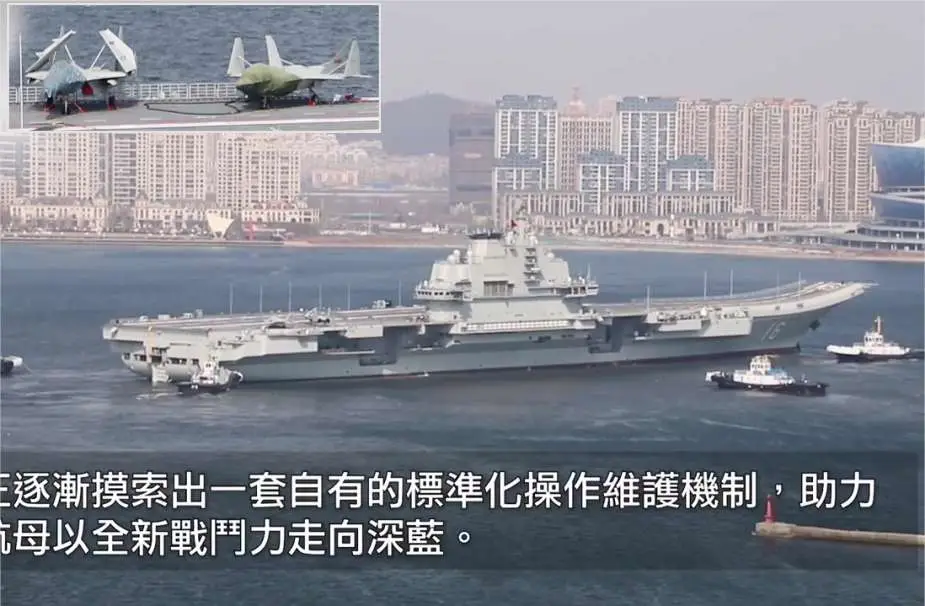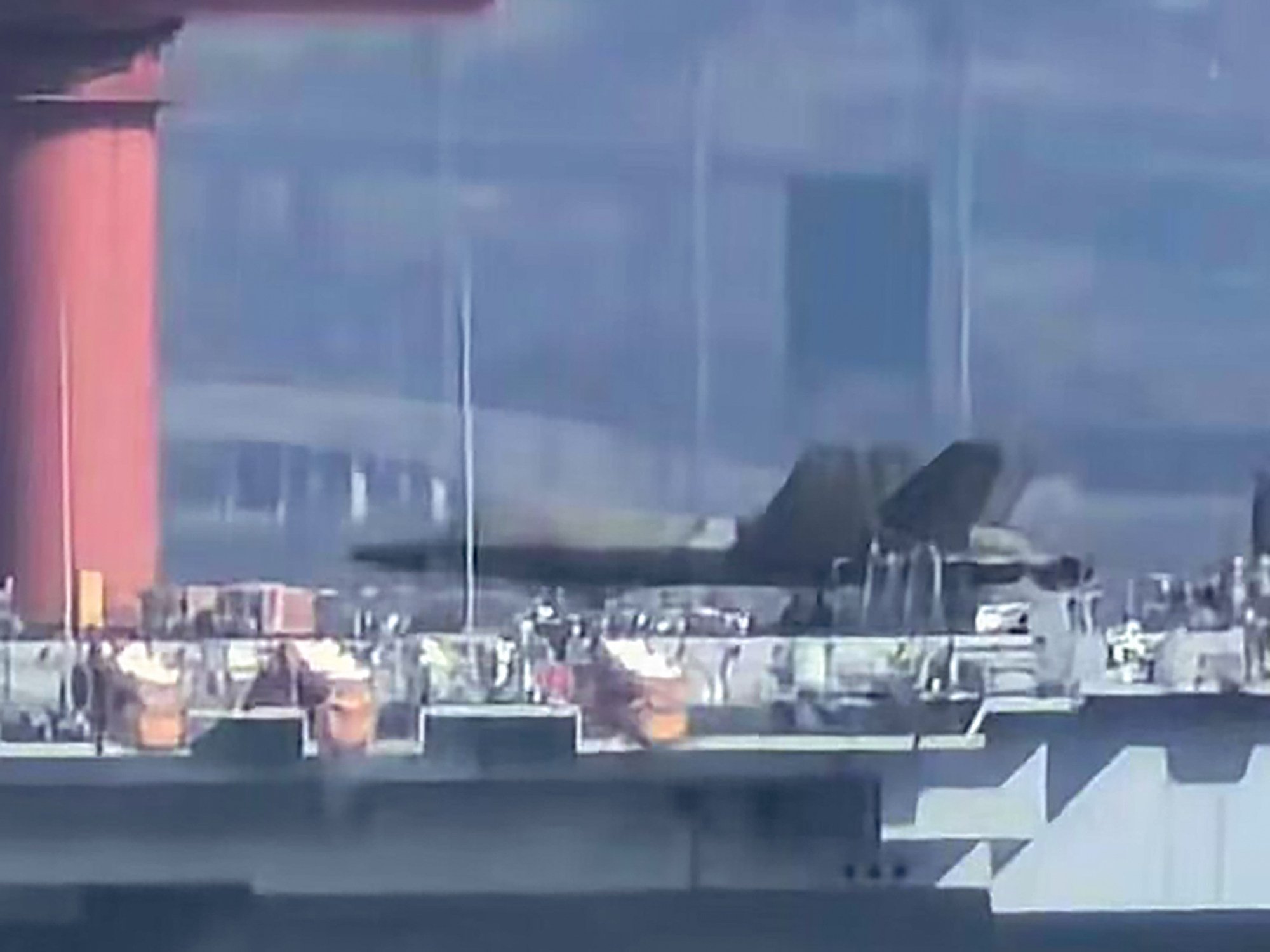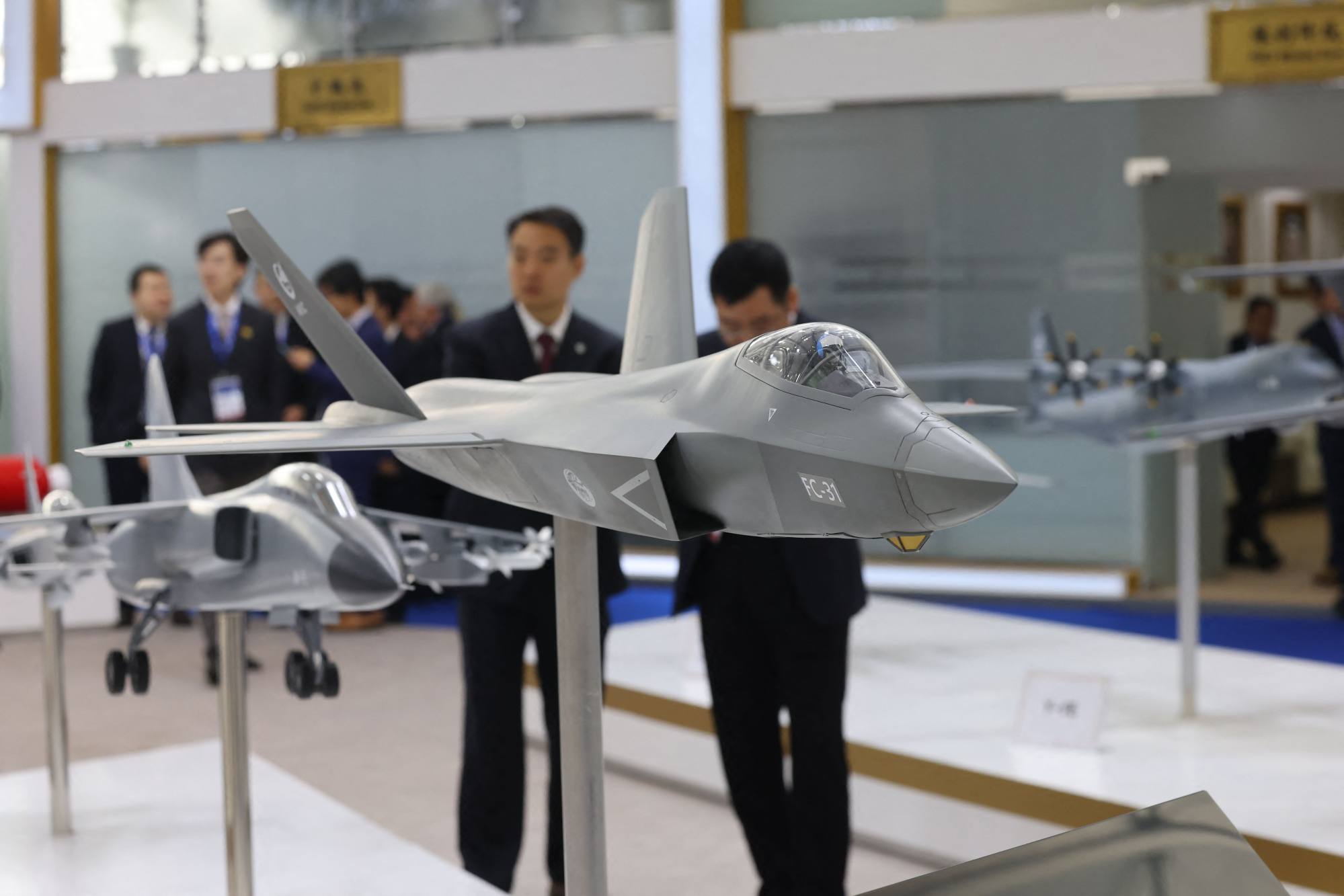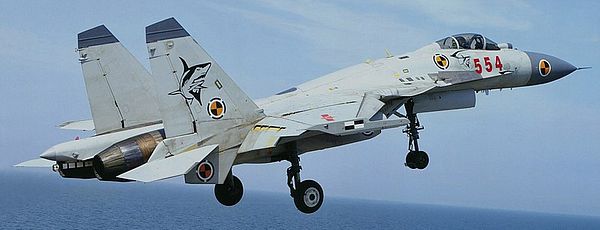Chinese Navy Liaoning aircraft carrier returns to sea with J-15 and J-35 jet mockups
As reported by Caiyunxiangjiang
Louis Cheung on February 29, 2024, a new video has provided a clearer perspective on
the J-35 mockup situated on the deck of the Liaoning aircraft carrier,
suggesting that the vessel, after its return to sea, is undergoing
deck-handling trials. This development is pivotal, as it suggests a
shift from previous plans which anticipated the deployment of the J-35
on China’s forthcoming generation of carriers, specifically designed
with catapult systems as opposed to the existing ski-jump ramps.

The Liaoning aircraft carrier of the Chinese Navy is back at sea
with mockups of J-15 and J-35 jets. (Picture source: Caiyunxiangjiang)
Additionally, the imagery showcases a mockup of the J-15 fighter alongside the J-35 on the Liaoning. The J-15, a regular component of China's operational aircraft carrier groups, particularly on the Liaoning and Shandong, appears to be undergoing evaluation for compatibility and training purposes in conjunction with the J-35. The presence of the J-15 mockup, potentially hinting at a new variant of the aircraft, is indicated by the unique shape of the cockpit area, which is visible beneath its protective covering.
The J-15, known in NATO terminology as Flanker-X2 and also referred to as the Flying Shark, is China's primary carrier-based aircraft. Originating from the design framework of the Russian Su-33, it incorporates two Shenyang WS-10A engines, achieving a maximum speed of 2,410 km/h and maintaining operational range capabilities up to 3,500 km. Despite its advanced design, the J-15's operational efficacy is partially restricted by the Liaoning's ski-jump launch mechanism, impacting its fuel consumption and thereby influencing its payload capacity and maximum takeoff weight.
Andreas Rupprecht, a noted observer of Chinese aerospace developments, has discussed the potential use of the J-15 mockups for the development of an electronic warfare variant, speculated to be designated as the J-15D. This variant would represent a significant step towards enhancing the electronic warfare capabilities of the People's Liberation Army Navy (PLAN), mirroring the functionalities of comparable systems like the U.S. Navy’s EA-18G Growler.
The employment of aircraft mockups is a recognized practice in naval operations for facilitating the training of deck-handling procedures, including the operation of aircraft elevators and the management of space on the flight deck and in hangar areas. Such practices contribute to the operational readiness and efficiency of aircraft carrier crews.
Recent activities involving the Liaoning, including the integration and testing of the J-35 and potential J-15D variants, signal a progression towards more advanced maritime operations. This also indicates a continued development of the capabilities of China’s current carrier fleet, which operates primarily with Short Take-Off But Arrested Recovery (STOBAR) systems, in contrast to the future catapult-assisted takeoff but arrested recovery (CATOBAR) systems planned for new carriers.
The J-35, specifically designed for carrier operations, while limited by the ski-jump ramp system, is expected to offer new operational capabilities. Designed for single-pilot operations, the aircraft is tailored for carrier compatibility and aerodynamic efficiency, featuring specifications that support its role in varied mission scenarios. The aircraft's design facilitates a balance between maneuverability and operational range, complemented by an array of advanced onboard avionic systems.
The unfolding scenario surrounding the J-35 and the upgraded J-15 variants on Chinese aircraft carriers reflects the country's ongoing efforts to expand and refine its naval air power capabilities. These advancements are indicative of China's broader military modernization efforts, aiming to enhance the operational scope and strategic depth of its naval forces. The Liaoning’s transition from a training to a combat platform, along with its adaptations for increased aircraft carriage and defensive capabilities, underlines the strategic evolution of China's naval ambitions and its engagement in expanding its maritime operational readiness.
Photos have been posted online of an apparent full-scale dummy of China’s new fifth-generation fighter on one of the country’s aircraft carriers.
The images began circulating on Weibo last week and appear to be of a model of a J-35 stealth fighter on the Liaoning, China’s first aircraft carrier.
Then on Monday state-owned, Hong Kong-based newspaper Wen Wei Pao published clearer pictures of the dummy wrapped in a tarpaulin on the carrier at a shipyard on the northeast coast owned by Dalian Shipbuilding Industry Company.

The J-35 is being developed by Shenyang Aircraft Corporation as China’s second fifth-generation fighter jet, following the J-20.
The jet is designed for use on aircraft carriers and is still in the development and prototype phase but it is touted as the Chinese equivalent of Lockheed Martin’s fifth-generation fighter jet, the F-35.
Collin Koh, a senior fellow at the S. Rajaratnam School of International Studies in Singapore, said the dummy of the J-35 could serve various purposes.
“One most straightforward assessment is that the Liaoning, which has long been designated as a test bed for PLA carrier capabilities, is conducting experiments on the J-35 as a viable carrier-borne fighter jet,” Koh said.
He said the dummy could also be for “signalling purposes”.
China at a Glance Newsletter
Your daily must-read of essential stories from China, including politics, economy and current affairs.
By submitting, you consent to receiving marketing emails from SCMP. If you don't want these, tick here
“The Chinese are possibly aware they’re being watched with interest by external parties so the mock-up is put out there in open view to send a veritable signal, possibly to the US,” Koh said.

A scale model of the J-35 was first unveiled at the Zhuhai Airshow in 2012 and observers say the most recent images indicate the jets could soon be in operation.
Once handed over to the People’s Liberation Army, the J-35 is likely to be mixed and matched with the fourth-generation J-15 already on the Liaoning and Shandong, China’s second carrier.
The J-35s will also reportedly be stationed on the Fujian, the country’s newest aircraft carrier, which is undergoing sea trials and expected to be in service by 2025.
Unlike its two predecessors, which used ski-jump take-off ramps, the Fujian has an electromagnetic catapult system that allows planes to be launched more frequently and with more fuel and munitions.
Yue Gang, a retired PLA colonel, said it was feasible to deploy the J-35 on all three Chinese carriers.
But the fighter’s guidance systems and maintenance facilities would have to be adapted for the Liaoning, the carrier that was commissioned over a decade ago.
“If the deployment test on Liaoning is successful ... the same deployment will be implemented on the Shandong and Fujian ships as soon as possible,” he said, adding that similar developments in Japan and the US had prompted China to speed up.
China airs footage of Fujian aircraft carrier featuring advanced catapult launch system
But having J-35s on carriers of different launch types could be challenging, according to Yoon Suk-joon, a visiting research fellow at the Korea Institute for Military Affairs and specialist in Chinese weapons systems.
“There is a significant technical and operational difference between the [ski jump ramps] and the [electromagnetic catapult] method,” Yoon said.
“This means that even if the J-35 type is mounted on the Fujian for sea trials, training is required for the carrier-based aircraft pilots already on the Liaoning and Shandong.
“There is a big difference between doing this on an actual aircraft carrier than on the ground.”
China has been promoting its new stealth fighters abroad in an attempt to present its aircraft as a choice for countries without access to US and European fifth-generation jets.
Chinese state-owned firms showcased a model of a J-35 – also known as the FC-31 – at the World Defence Show in Riyadh, Saudi Arabia, earlier this month. It was also featured in the International Defence Exhibition and Conference in Abu Dhabi last year.
Last month, Pakistani Air Chief Marshal Zaheer Ahmed Baber Sidhu announced that his country planned to buy the jets as part of plans to modernise its air force, but did not give further details of the procurement.
Koh said that he was not aware of potential buyers other than Pakistan.
“Still, the J-35 would serve as a potential alternative buy among a host of offerings worldwide, and depending on the client’s financing ability and mission requirements, as well as political considerations,” Koh said.
“But for now, one can only say the J-35 has potential, especially among the less-endowed air arms around the world, in particular in the developing world.”
8982.jpg)


No comments:
Post a Comment